Have you ever been through a website or an app that sticks with your mind? You find the graphics, menus, buttons, and links on the page just perfect. Everything about the design seems aligned with the brand. Design systems make that happen!
Some people may disagree, but design systems are useful. More than that, they never take away the creative freedom. Although a design system is a set of principles, rules, and reusable components, you don’t have to follow all of them. You can creatively bend the design to your advantage through the components presented by the design system.
You have to make use of design systems to make designs that grab the user's attention. Is consistency so important? Do design systems work? What lies ahead for design systems in 2025 and beyond?
Let’s find out!
Why is Consistency Important in UX?
The design landscape is highly dynamic and unpredictable. It is evolving daily. What's popular today might not work tomorrow.
When talking about unpredictability, it is important to think of consistency. It is the most fragile design principle that impacts the user experience. That’s because when things stay the same each time, people start to trust the product more. The lack of it can negatively impact your brand reputation and business outcomes.
Does consistency ensure good UX? The answer is not that simple.
While UX design consistency is important, too much consistency can lead to boring designs. We do believe that consistent elements can make the brand identity strong. However, the same designs over and over again can lead to visual fatigue.
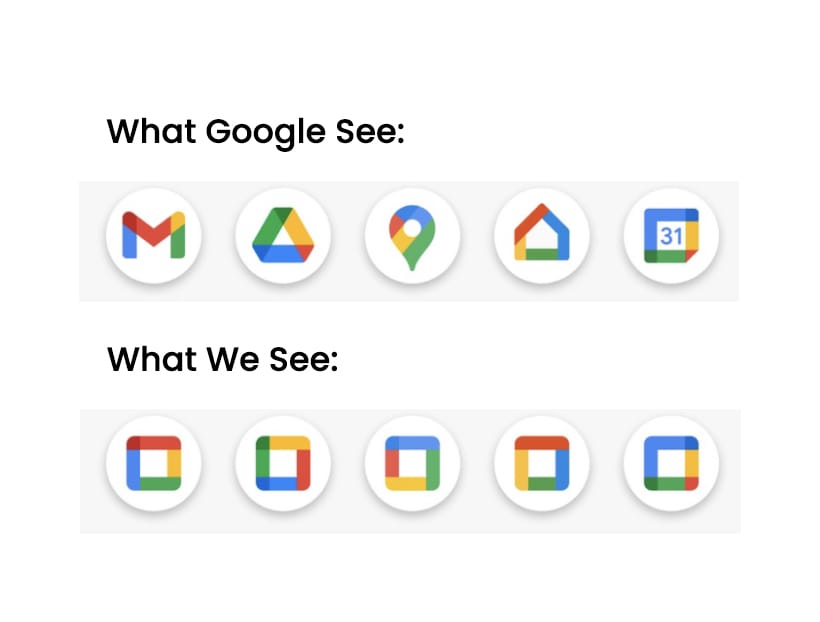
Let’s take this example. Google changed how its app icons look a few years ago to make sure they all match and look like part of the same family. However, we can all agree that these uniform designs made them uninteresting.
What's the takeaway? Consistency is important, but sometimes breaking the rules is even more crucial. Creative consistency means showing things in a fun and interesting way while still keeping the brand’s look and feel the same. This is what is needed.
Now that we know about design consistency and how it impacts the UX of your digital products, let’s discuss design systems.
Are Design Systems Important in 2025?
There’s an age-old debate regarding design systems. Some say that design systems save time by reducing rework and reusing components. They give examples of companies like Google, IBM, and Adobe. While others believe design systems are a waste of time. These designers say that design systems stop creativity.
Does that really stop creativity? No! A design system is not the enemy of creativity. Instead, they encourage designers to channel the creative energy smoothly.
Let's face the fact that almost everyone loves templates or Figma libraries. Are they efficient? Yes! Are they boring? Well, that depends. It is up to designers to utilize design systems and create elements that fully leverage the potential of these systems.
It is also a fact that design systems are not always successful. Only 40% of design systems are successful. So, why do 60% of design systems fail? What is the problem with design systems?
In 2025, businesses have to provide a unified experience. User interaction must be seamless across devices and channels. That's why the product and marketing teams should unite to provide the users with a unified experience.
What are the top reasons for design system failure?
- Lack of adaptability
- Providing too much visual consistency
- Teamwork
- Maintenance
- Ignoring the users
There should be a perfect mix of consistency and creativity when it comes to UX. You have to design things that are engaging yet consistent. You have to push the boundaries of the design systems to reap the maximum benefits.
For instance, let’s take this example. Look at this Lego car.

Now, look at this one.

Both of them are made of Lego blocks. But the latter is much more attractive than the previous one. Why? What makes the red car much more attractive is that the Lego blocks were not used normally. An extraordinary design was pushed through the same Lego blocks through proper planning.
The design system is the Lego blocks, and the car is the design. How you make use of the design system is all that matters.
Here are some facts about design systems that everyone should know.
- A design system is not just component libraries but all about the what, how, and why of designs.
- A design system is a tool. Don’t assume that a great design system will guarantee
good quality. It is simply a tool meant to accelerate the design process.
- The design systems are always incomplete. They are foundational stones on which you build your designs and improve.
Defining a design system is not possible. We can describe them vaguely. Let’s explore some of the things they are.
- A design system maintains consistency. However, too much consistency will bring monotony.
- These systems make development faster. However, faster development often results in poor-quality designs.
- They free designers to focus on specific problems. On the contrary, design systems imprison designers within specific boundaries.
So, there’s no black and white when it comes to using design systems. It all lies in the grey area. You have to know how to use it to make something outstanding instead of relying completely on it or ignoring it at all costs.
The Role of Design Systems in Maintaining UX Consistency
The role of design systems goes beyond maintaining design consistency. It is also about scaling the design and bridging the gap between product development and design. They even push designers towards creativity. Here’s how.
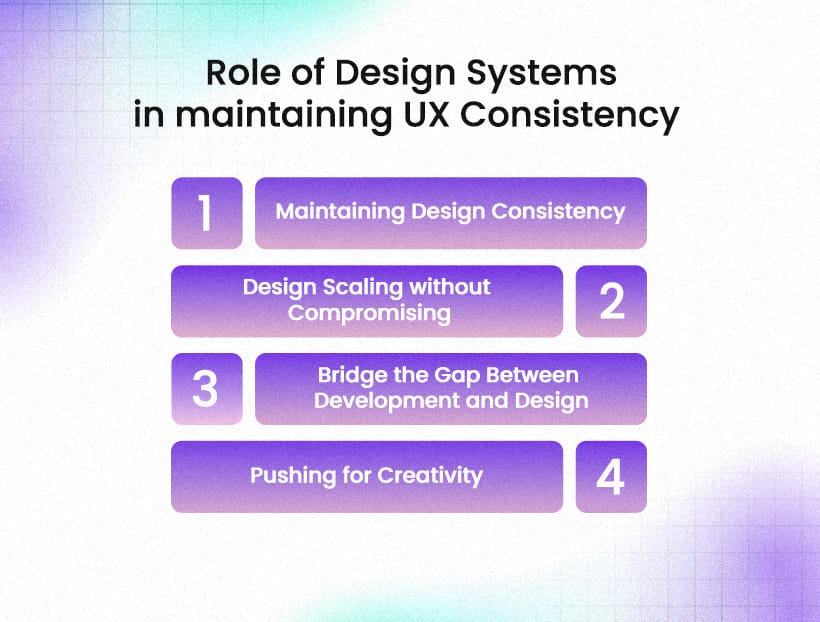
1. Maintaining Design Consistency
Suppose you’re using an app. The buttons in the app vary in color and size on different pages. Also, the navigation is confusing as the menus are arranged differently for different sections. Will you use it? No, right?
You will become frustrated with the app as you will have to spend time and energy to interact with it. This is where design systems can help with consistency. A consistent design will make your interaction fun and smooth.
Design systems give designers ready-made parts like forms, buttons, text styles, and layouts that look the same on every page. When users go through the same pattern multiple times, a muscle memory is developed. This allows seamless navigation.
2. Design Scaling without Compromising Quality
For some products, design scaling can be a major challenge. As the products scale, maintaining design quality becomes necessary.
Without proper scalable design systems, designers might develop elements that are absent from the patterns. This leads to a fragmented user experience. A design system allows designers to reuse elements, which saves time and ensures the UI is consistent.
3. Bridge the Gap between Development and Design
Clear communication is important between the design and the development team. Miscommunication can lead to different interpretations, leading to inconsistencies in the product. Design systems mitigate this issue. They provide guidance and documentation that ensures developer collaboration and make sure that both teams are working with the same objectives.
4. Pushing For Creativity
As we already discussed, some people think that these systems limit creativity. They force designers to stick to rules. But a good design system frees designers from repeated tasks and allows them to focus on other problems. These are the problems that demand creativity.
Design Systems in Action: Real World Examples
Are you still not convinced that design systems work? Guess what, the top companies like Google, Apple, Microsoft, Adobe, and so on have their design system in place. These systems have their unique approach to resolving specific design challenges.
Google Material Design System
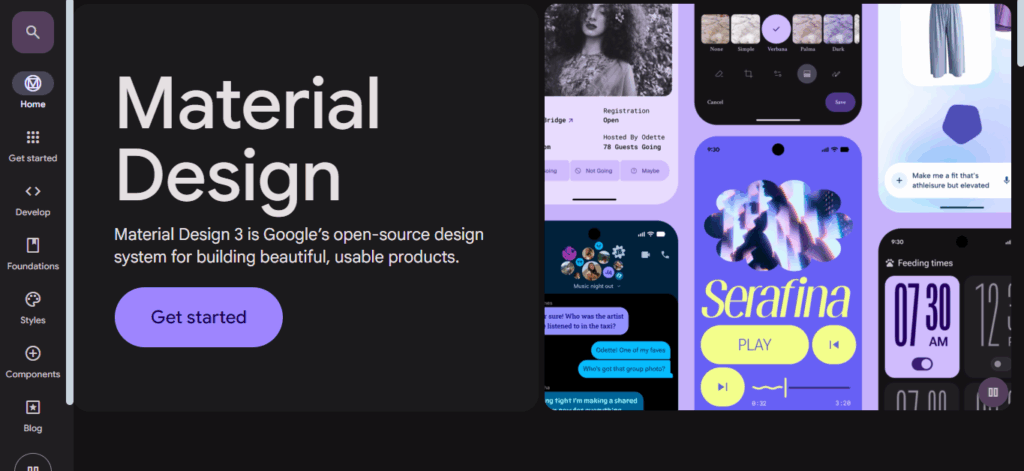
This design system came out in 2014 and has become one of the most popular and important ones since then. You can even check them out in Google products such as Gmail, Android OS, and Google Drive.
Apple Human Interface Guidelines
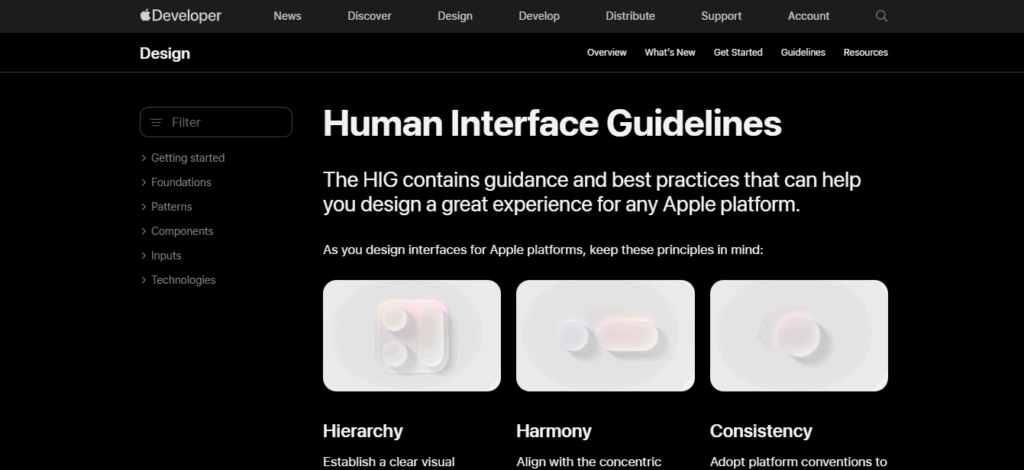
Apple’s HIG is famous for paying close attention to small details and making apps easy and smooth to use. While this design system is app-oriented, it can also be applied to web designs.
IBM Carbon Design System
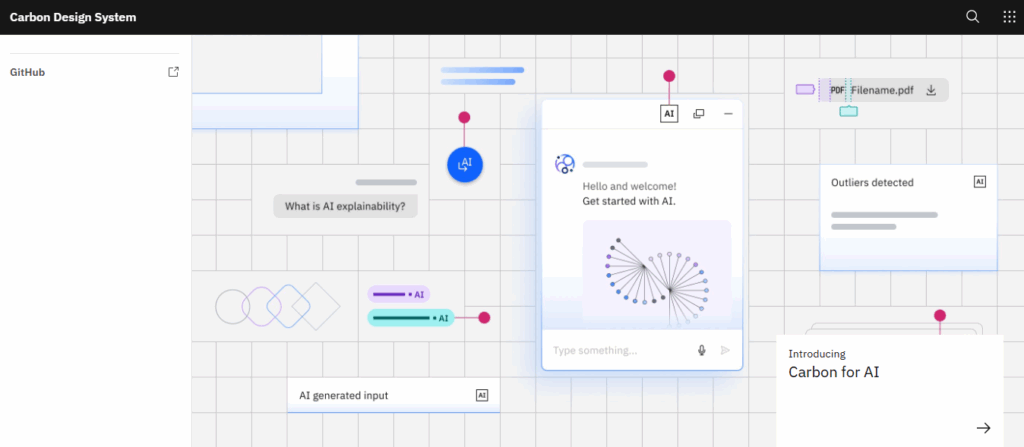
This one is a robust and open-source design system. The IBM Carbon Design System is for enterprise-grade applications and websites. It is known for its accessibility, flexibility, and scalability. It is built to handle large projects and guarantees consistency in design.
Microsoft Fluent
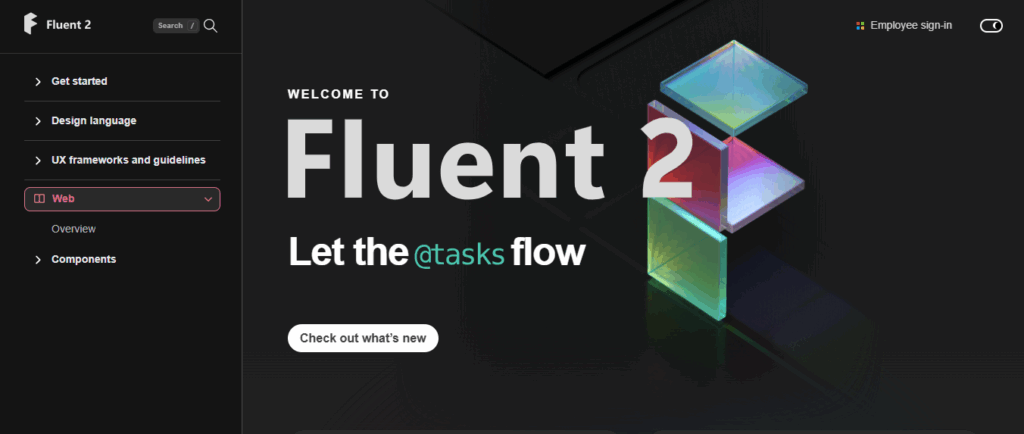
This design system focuses on delivering engaging and intuitive UX across various platforms. Fluent makes interactions and navigation feel natural. This develops a sense of ease and familiarity in the users. It is best for apps and services for Windows, iOS, Android, and web. You can see its glimpse in the flagship products of Microsoft, including Teams and Office 365.
Adobe Spectrum
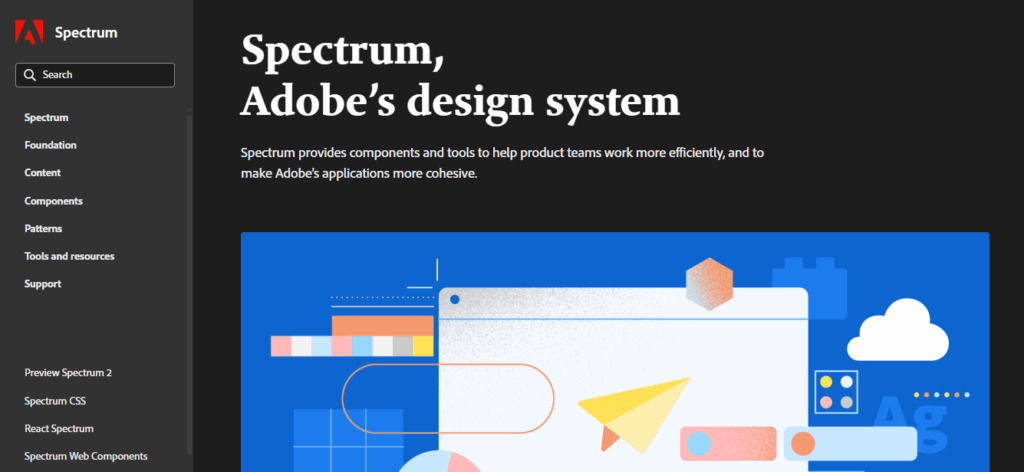
Developed by Adobe, the Spectrum design system mixes accessibility with flexibility. It has a flexible theming system and a strong component library, making it a top choice for web designers. The system is known for adaptability and consistency.
What Lies Ahead: Design System Trends in 2025 and Beyond
By now, you already know how important design systems are for user experiences. They are fundamental to the development of digital products.
Design systems not only provide consistency but also scalability and efficiency. In this section, we will be talking about the top 3 trends that will change design systems for good.
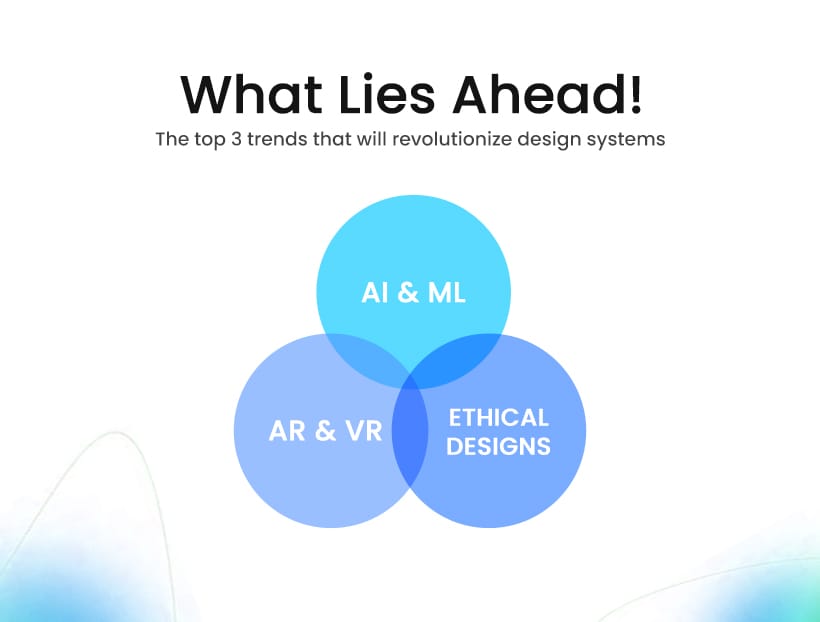
AI and Design Systems
AI and ML will surely automate workflows. This will make the systems more personalized and smart.
- Automation: AI can help by picking colors, creating page layouts, and building buttons or menus based on how people use the app or website.
- Accessibility: ML can be used to check compliance issues and suggest fixes.
- Personalization: The live data will allow adjustments in real-time, enhancing UX.
AR and VR Integration
As AR and VR become mainstream, the design system will evolve to allow immersive experiences. This will be achieved through:
- 3D UI/UX Guidelines: The design systems will adapt to provide immersive experiences to the users.
- Standardized Components: The integration of standardized components will make sure that the design is consistent during AR/VR development.
- Prototyping Tools: This lets designers try out their ideas in virtual spaces before actually building them.
Ethical Designs
As people care more about the planet and doing the right thing, design systems will be made in ways that are better for the environment.
- Inclusive Designs: Design systems will make sure the designs are accessible to everyone.
- Sustainable UI: Designers will try to make things that use less data and energy, while still working just as well.
- Privacy-Oriented Designs: This will enhance the user trust and data transparency.
Final Thoughts
You cannot ignore consistency in your designs. It can be bent but not broken. Too much reliance on consistency can hamper your designs. So, what's the solution? Creative consistency! You have to provide consistency, but with a touch of creativity.
Design systems are just for that. They provide the foundational stone on which you build your designs. In the design world, rules are meant to be broken. Your rebellion might set an example for other designers to follow. This goes a long way when you want to achieve exceptional business results with your designs.
Remember, design systems are neither your enemy nor your friend. They are just there to help you begin creating something extraordinary. With trends like AI, ML, VR, AR, and ethical designs, the design system is all set to transform the business landscape. So, leverage them carefully to achieve results beyond your expectations.

